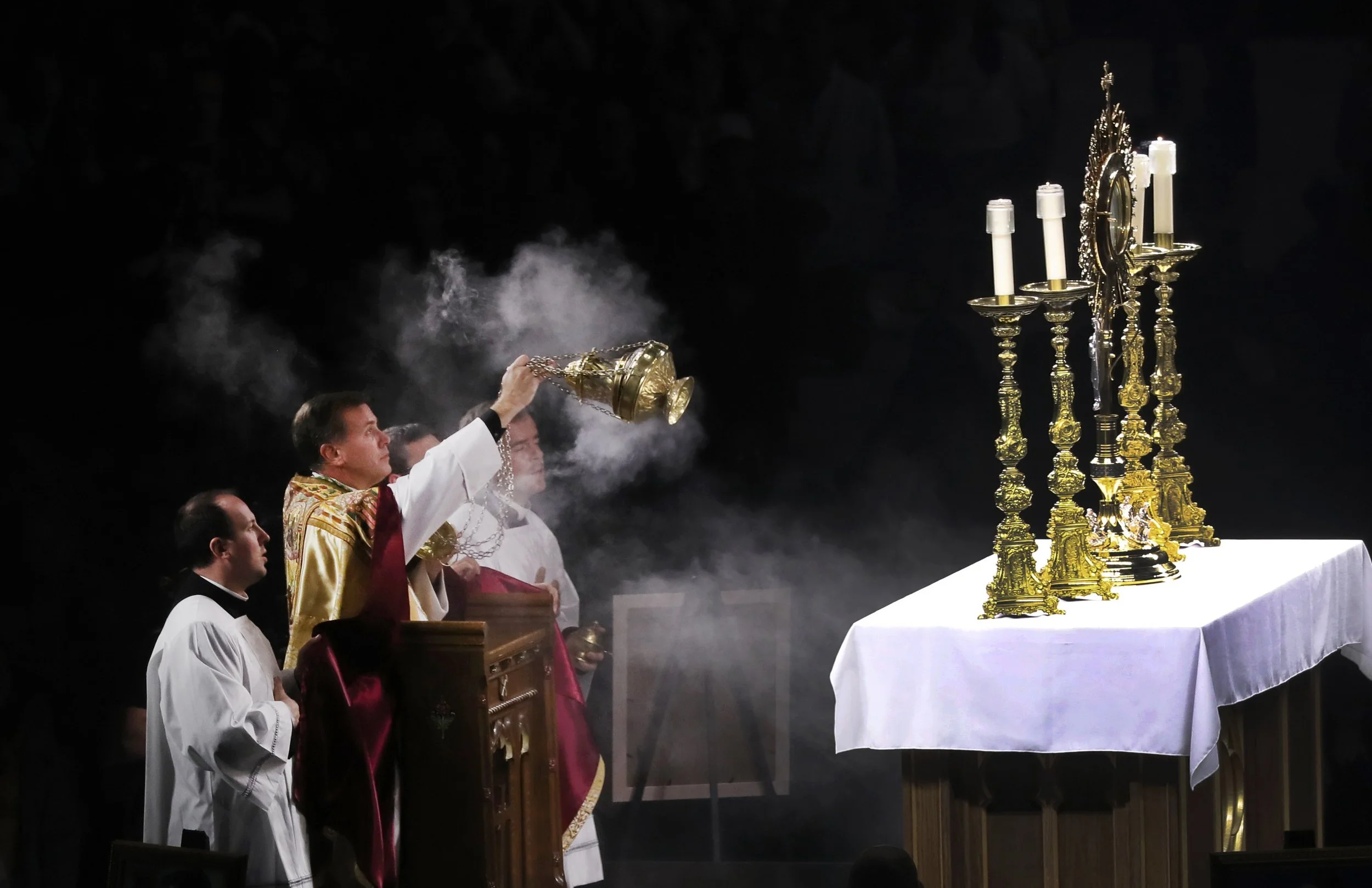Eucharistic Adoration Liturgy
The exposition and adoration of the Holy Eucharist are distinct liturgical and devotional practices rooted in the Church’s belief in Christ’s real presence under the appearances of bread and wine. These rites extend the Eucharistic celebration beyond Mass, inviting the faithful into silent worship, communal prayer, and benediction of Our Lord in the Blessed Sacrament.
Historical Development
The practice of reserving and venerating the Eucharist outside Mass dates back to the early centuries of Christianity. In the second century, deacons carried the consecrated bread to those absent from Sunday celebrations. By the third century, portions of the Eucharist were reserved in home “arcae” for distribution during the week.
Perpetual reservation and adoration, as we know them, emerged in the 13th century when the laity began to regard the visible host elevated at Mass as the high point of worship. The Middle Ages saw the rise of Eucharistic processions, pilgrimages, and the famous “Forty Hours” devotion, popularised by saints such as Philip Neri and Ignatius of Loyola.
The Liturgical Movement and the Second Vatican Council further shaped modern eucharistic theology. The Council’s Constitution on the Sacred Liturgy reaffirmed the Eucharist as “the summit toward which the activity of the Church is directed” and recovered the early Church’s understanding of Christ’s multiple presences—in the minister, the Word, the sacred species, and the assembly itself.
Theological Foundations
At the heart of exposition and adoration lies the Church’s infallible teaching that, at consecration, bread and wine become the Body and Blood of Christ, retaining only the accidents of bread and wine. This Real Presence calls forth worship (latria) reserved to God alone.
Adoration before the reserved Eucharist “extends the union which we have reached with him in Holy Communion,” drawing believers deeper into the paschal mystery of Christ’s passion, death, and resurrection. It underscores the Eucharist’s dual nature as sacrament and sacrifice, inviting ongoing personal and communal encounter with the living Lord.
Adoration or Exposition?
Adoration refers to private or communal devotion before the Blessed Sacrament reserved in the tabernacle. It is normative and does not require a formal rite.
Exposition entails the solemn public display of the Eucharist in a monstrance or ciborium, following the Rite of Exposition and Benediction set forth in Holy Communion and Worship of the Eucharist Outside Mass (HCWEOM).
Exposition has a clear beginning and end, often framed by hymns, readings, and benediction, whereas adoration may be perpetual or occur in scheduled intervals without prescribed liturgical form.
The Rite of Exposition
Relationship with the Mass
The Church carefully balances exposition with the primacy of the Mass. Exposition never overshadows the Mass but “invites us to the spiritual union with him that culminates in sacramental communion”. Extended exposition is interrupted during the celebration of Mass, and hosts used for exposition should be freshly consecrated to maintain the connection with the Eucharistic sacrifice.
Structure of the Rite
Exposition Song
A hymn such as O Salutaris Hostia is sung as the presider places the Blessed Sacrament into the monstrance on the altar.Exposition
The Blessed Sacrament is solemnly exposed, often following a procession from the place of reservation or directly after Mass.Adoration
Scripture Readings: Passages from the Lectionary or Mass of the day.
Liturgy of the Hours: Morning or Evening Prayer to deepen communal prayer.
Prayers and Songs: A selection of hymns, antiphons, responsories, or the Litanies of the Saints.
Silent Prayer: Ample time for private reflection and devotion.
Benediction
The presider incenses the monstrance and sings Tantum Ergo.
A humeral veil is used to handle the monstrance, emphasizing that only Christ, not the minister, is blessing the faithful.
The priest blesses the assembly with the Blessed Sacrament, followed by the Divine Praises.
Reposition
A concluding hymn (e.g., Holy God, We Praise Thy Name) accompanies the return of the Eucharist to the tabernacle.
An acclamation may follow as the Sacrament is reposed.
Ministers and Vesture
Ordinary ministers: A priest or deacon presides, exposing and later blessing with the sacrament.
Extraordinary or commissioned ministers: Laypersons may assist by placing the host in the monstrance and returning it to the tabernacle but may not impart the blessing.
Vesture reflects the dignity of the rite:
The presiding Priest wears a white alb and stole, cope, and humeral veil for benediction.
Assisting priests may wear a white alb and stole, or a pleated white cotta over a black cassock and a stole over the cotta.
In-Chapel private adoration may require simply a black cassock, a pleated white cotta and stole, or simply the stole over the black cassock may be sufficient.
Lay ministers may vest in an alb or dignified attire, ensuring reverence and decorum.
Acolytes and other Altar servers should wear a server’s black or red cassock and a short gathered cotta or alternatively, a server’s white alb.
Forms of Adoration
Private or Communal Devotion
Whether before the tabernacle or during exposition, adoration can include:
Mental Prayer: Personal conversation with Christ, pouring out joys, sorrows, and petitions.
Scriptural Meditation: Reflecting on selected Bible passages that speak to God’s presence and promise.
Rosary or Litanies: Marian devotion or the Litany of the Sacred Heart, inviting Mary’s intercession and Christ’s mercy.
Silent Presence: Simply “being” in God’s presence, listening to what He may communicate to the heart.
Forty Hours / Perpetual Exposition
Forty Hours Devotion: A historical three-day solemn exposition, rotating adorers to ensure continuous prayer, popularised and still in use since the 16th century.
Perpetual Adoration: Continuous exposition in a chapel, typically maintained by religious communities; parishes require episcopal permission to adopt this practice.
Pastoral Considerations
Connection to Mass
Exposition should lead participants back to the Eucharistic table, fostering greater participation in Mass and frequent Communion.Environment
Churches should be well-lit and suitably arranged, with appropriate candles, music, and seating to encourage reverence.Accessibility
Scheduled times (weekly, monthly, annual solemnities) and perpetual chapels make adoration available to diverse schedules.Security and Reverence
Perpetual exposition demands safeguards: at least two adorers present, secure premises, and clear guidelines to prevent abuses and sacrileges.Indulgences and Spiritual Enrichment
The Church grants special indulgences for time spent in adoration and during benediction, motivating the faithful to deepen their devotion.
Spiritual Fruits
Eucharistic exposition and adoration bear profound spiritual benefits:
They deepen awareness of Christ’s abiding presence, transforming devotional life into continual worship.
They nourish interior conversion, fostering compassion, forgiveness, and missionary zeal.
They strengthen communion with the Church, reinforcing unity through shared veneration of the sacrament.
Pope Benedict XVI urged priests and laity alike: “Be assiduous in the prayer of adoration and teach it to the faithful. It is a source of comfort and light, particularly to those who are suffering”.
Summary
The exposition and adoration of the Holy Eucharist weave together the Church’s liturgical tradition, theological depth, and pastoral care. By unveiling the Blessed Sacrament, the faithful are drawn into silent worship, enriched by Scripture, song, and sacramental blessing. Through these rites, Christ’s paschal mystery continues to unfold in hearts and communities, urging all to gaze upon Him, to rest in His presence, and to be sent forth as living witnesses of His love in the world.
Eucharistic Adoration Liturgy Books
Eucharistic Adoration
Eucharistic Adoration
Eucharistic Adoration






